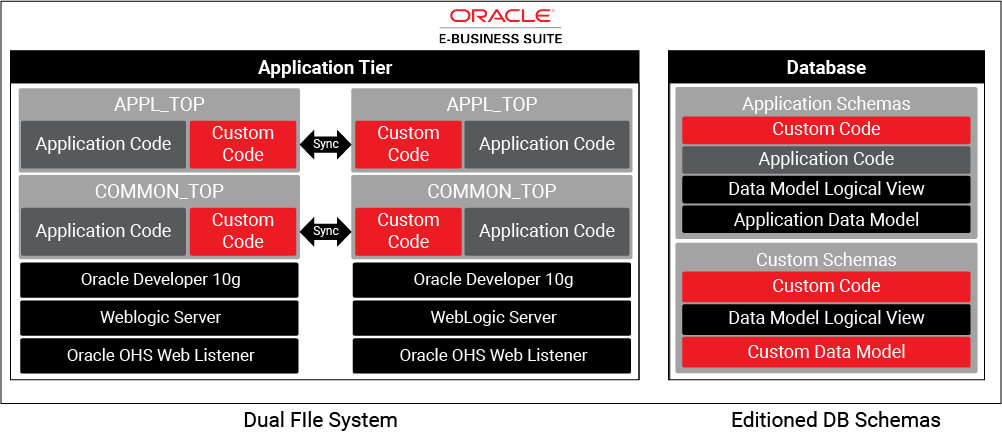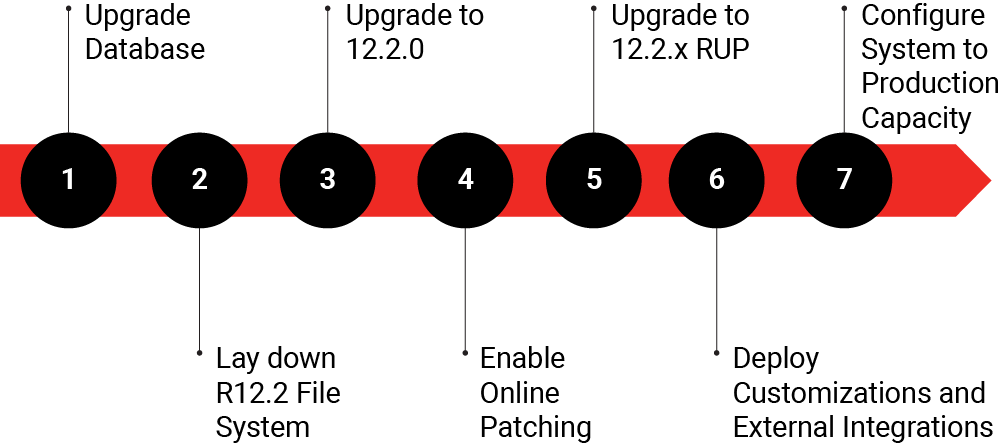Oracle E-Business Suite (EBS) is an “integrated set of business applications developed to help organizations manage CRM, ERP, and supply chain processes.” For years, it has been the golden standard in the industry for enterprise resource planning (ERP) applications, and has cemented itself as a valuable fixture in Oracle’s portfolio of product lines.
For years, your business has been using Oracle EBS to support your day-to-day operations, oftentimes handling mission-critical tasks that ensure your business runs smoothly and efficiently. But, how do you ensure your business continues to run smoothly if you’re running below what Oracle considers under the scope of its Continuous Innovation model?
How do you justify working on an outdated version of the Oracle EBS software, and as a result, exposing your business to the risks and costs associated with being out of Oracle Premier Support?
All Oracle EBS customers running on 12.1 or below are playing the dangerous game of surviving on a somewhat stable version of the software but even the smallest sign of risk can completely halt their operations and potentially lose hundreds of thousands of dollars as a result of being unpatched, desupported, and underperforming.

Unfortunately, we’ve seen firsthand how damaging being out of Premier Support can be with some clients shutting down operations because of a single bug that is solved in Oracle EBS R12.2.x but not on previous versions. It’s not a good place to be in.
We know that some clients are hesitant about making the upgrade to Oracle EBS R12.2.x because they are either migrating to the cloud, are afraid of breaking something that’s “working”, or haven’t found the right balance of minimizing risks, reducing costs, and ensuring knowledge transfer.
All reasons are valid, but what’s also true is that application modernization is imminent and should be immediate. After the COVID-19 pandemic, many organizations were faced with the challenges of the destabilizing events caused by the uncertainty of a global health crisis, entire workforces moving to work remotely, and social and economical distress. Under these circumstances, one of the key realities that stood to surface was that application modernization should be at the top of every business agenda seeking to accelerate their digital transformation journeys.
Among those Oracle EBS clients that are unsure of upgrading their Oracle EBS to R12.2.x, one common denominator we find is the perceived concern of dealing with large volumes of software customization.
Customizations, also referred to in the field as CEMLIs, are short for Configurations, Extensions, Modifications, Localizations, and Integrations. A mouthful for sure, so let’s stick to CEMLIs.
When thinking about your application modernization strategy to upgrade to Oracle EBS R12.2, it’s important that your team carefully review CEMLIs as they are a critical component of the technical effort involved in the 12.2 upgrade.
CEMLIs should be identified, understood, and assessed under the parameters of criticality and complexity to more accurately determine if they and how many can be replaced with Oracle EBS R12.2.x standard functionality.
Some companies have astronomical amounts of CEMLIs, which can make the upgrade effort harder than most. Years ago, Oracle EBS admins relied on CEMLIs to address non-standard processes and practices, which in simple terms means there simply wasn’t enough EBS functionality to serve their unique needs. With newly introduced innovations, CEMLIs that step out of the comfort of workflows, integrations, and reporting, it’s very likely you won’t be able to migrate them to the latest version of the Oracle EBS software.
This doesn’t mean you’ll lose functionality. Instead, it means there’s new standard functionality in the Oracle EBS R12.2.x software that makes it possible for you to completely eliminate customizations, depending on what the CEMLI addresses. Which is where Oracle EBS customization best practices kick in.
Now, when deciding which customizations can be migrated to Oracle EBS R12.2, as part of the aforementioned Oracle EBS customization best practices, it’s important that you assess if they comply with Online Patching development standards and patching procedures. They also need to exist in both file systems of Oracle EBS and there would need to be custom schemas with dependencies on EBS objects that are edition-enabled. See image below.
Customization in Oracle E-Business Suite R12.2

Following up on the subject of Oracle EBS customization best practices, you can get started with preparing customizations for the R12.2.x upgrade by:
- Create a CEMLI catalog that includes artifacts in the database, middle tier, and technologies.
- Analyze and implement code remediation using Online Patching readiness reports and Online Patching standards compliance reports. These reports are available as standalone patches for 11i, 12.0, 12.1, and 12.2.
- Deploy revised customizations compatible with pre-12.2 releases as well as remediated CEMLIs deployed on the current production environment or with deployment deferred to the upgrade downtime.
For more information about the Oracle EBS customization best practices including customization standards required to be compliant with Online Patching, please download our infographic.
To further expand, here’s how a traditional R12.2.x technical upgrade process looks like:

It seems easy enough, right? Easier said than done, the CEMLI Remediation or CEMLI Modernization exercise is complex, nuanced, and multi-layered, typically involving the expertise of consultants who’ve worked with CEMLIs before and are well versed in understanding the Oracle EBS adherence standards, making it possible to successfully apply Oracle EBS customization best practices.




